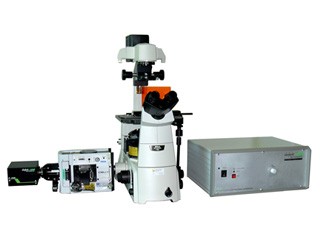Download Brochure

The combination of the LIFA with the renowned Yokogawa CSU-X1 multibeam confocal spinning disk provides fast confocal fluorescence lifetime imaging microscopy in the frequency domain. The system delivers the high depth resolution lifetime imaging often requires, e.g. in sub-cellular lifetime studies, and removes the out-of-focus light.
The CSU unit is mounted between the microscope and the TRiCAM modulated intensified CCD camera is mounted to the camera port of the spinning disk. For excitation Lambert Instruments provides the modulated Multi-LASER.
The CSU unit has been succesfully tested on Leica, Nikon, Olympus and Zeiss microscopes. We offer the system as a complete CSU-X1 confocal fluorescence lifetime imaging microscopy package or as a LIFA fluorescence lifetime imaging microscopy upgrade to an existing CSU.
The Lambert Instruments LIFA is easy to install - within the hour - and easy to operate. It is particularly well suited for high-content screening applications. The LIFA system has been judged "easy and highly quantitative" for a.o. FLIM-FRET studies.
Hardware features
-
Multi-beam fast fluorescence lifetime imaging microscopy, up to two lifetime images per second
-
Non-phototoxic illumination offered by the new Laser Box
-
Lifetime sensitivity 0-300 ns
-
Lifetime accuracy 50 ps r.m.s.
-
High quantum efficiency with the optional Gen III GaAs intensifier
Software features
-
Time-lapses
-
FRET efficiency mapping
-
Multi-frequency acquisition & analysis for separation of multiple lifetimes
-
Polar (Phasor) plot inspection and separation of multiple lifetimes
-
Easy integration into specialized image analysis pipelines
Options
Support for automated microscopes
Nikon Ti Eclipse.
Support for XYZ stages
Lambert Instruments provides the following LIFA models, which cover a wide range in spectral sensitivity and in lifetime sensitivity. Each model is based on a specific high-resolution Gen II or Gen III image intensifier, see also our fluorescence lifetime imaging microscopy properties of modulated intensifiers document.
Model
|
Photocathode
|
Modulation frequency
|
Lifetime sensitivity
|
|
LIFA Gen II S20 |
S20 |
1-120 MHz |
0-300 ns |
|
LIFA Gen II S25 |
S25 |
1-120 MHz |
0-300 ns |
|
LIFA Gen III GaAs |
GaAs |
1-120 MHz |
0-300 ns |
|
LIFA X Gen II S20 |
S20 |
0-100 kHz, 1-120 MHz |
0 ns - 1 ms |
|
LIFA X Gen II S25 |
S25 |
0-100 kHz, 1-120 MHz |
0 ns - 1 ms |
|
LIFA X Gen III GaAs |
GaAs |
0-100 kHz, 1-120 MHz |
0 ns - 1 ms |
|
LIFA P Gen II S20 |
S20 |
0-100 kHz |
100 ns - 1 ms |
|
LIFA P Gen II S25 |
S25 |
0-100 kHz |
100 ns - 1 ms |
|
LIFA P Gen III GaAs |
GaAs |
0-100 kHz |
100 ns - 1 ms |
|
LIFA P Gen III GaAsP |
GaAsP |
0-100 kHz |
100 ns - 1 ms |
Photocathode spectral sensitivity
Spectral sensivity as a function of wavelength for each of the photocathodes is shown below.

For more information, please refer to our technologies page on the operating principle of image intensifiers for lifetime imaging.
-
Molecular interactions
-
Protein conformation
-
Biosensors
-
Oxygen concentration imaging in cells and tissue
-
NADH / FAD fluorescence dynamics
-
Viscosity imaging
-
Membrane dynamics
-
Membrane trafficking


